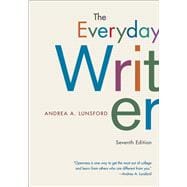Empowering and inspiring, Andrea Lunsford offers a handbook for our times. The Everyday Writer, Seventh Edition, invites students to think rhetorically, communicate ethically, listen respectfully, experiment with language, and adopt openness as a habit of mind necessary for democracy.
The seventh edition introduces new chapters on college expectations and on language and identity as well as substantial new advice for reading and interrogating sources, seeking common ground with opponents, using varieties of English, and being open to new approaches in common academic genres. New student models of rhetorical analysis, researched argument, speech, and translingual narrative invigorate the book. As always, Lunsford’s Top Twenty--now its own tabbed section--serves as a guide for building students’ confidence as editors of their own writing.








